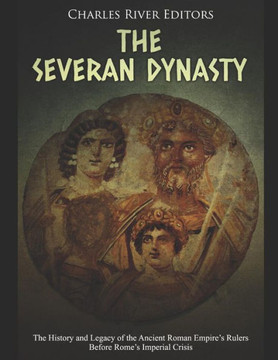
Independently Published
The Severan Dynasty: The History And Legacy Of The Ancient Roman Empire'S Rulers Before Rome'S Imperial Crisis
Product Code:
9781798752272
ISBN13:
9781798752272
Condition:
New
$11.51

The Severan Dynasty: The History And Legacy Of The Ancient Roman Empire'S Rulers Before Rome'S Imperial Crisis
$11.51
*Includes pictures *Includes ancient accounts *Includes online resources and a bibliography for further reading "If a man were called upon to fix that period in the history of the world during which the condition of the human race was most happy and prosperous he would, without hesitation, name that which elapsed from the deaths of Domitian to the accession of Commodus." - Edward Gibbon "The Five Good Emperors," a reference to the five emperors who ruled the Roman Empire between 96 and 180 CE (Nerva, Trajan, Hadrian, Antoninus Pius, and Marcus Aurelius), was a term first coined by Machiavelli and later adopted and popularized by historian Edward Gibbon, who said that under these men, the Roman Empire "was governed by absolute power under the guidance of wisdom and virtue." This period of 84 years is generally regarded as the high point of the Roman Empire, at least after Augustus, but what is uncertain and a matter of ongoing debate is whether the five emperors were personally responsible for the situation and the accompanying prosperity enjoyed throughout the empire at the time or if they were simply the beneficiaries of the Pax Romana, inaugurated by Augustus in the early part of the 1st century CE. In other words, historians have wondered whether anyone in power during those years would have enjoyed the same rewards. With all of that said, according to some academics, the success these rulers had in centralizing the empire's administration, while undoubtedly bringing huge benefits, also sowed the seeds for later problems. After all, as so many Roman emperors proved, from Caligula and Nero to Commodus, the empire's approach to governance was predicated on the ruler's ability. When incompetent or insane emperors came to power, the whole edifice came tumbling down. The Severan dynasty came shortly after the Five Good Emperors, and it also consisted of five emperors who ruled the empire from 193-235, except for a brief interlude between 217 and 218 when Macrinus held the imperial throne. In chronological order, the five were Septimius Severus the Founder (193-211), Caracalla (198-217), Geta (209-211), Elagabalus (218-221), and Alexander Severus (222-235). Their reigns coincided with the period in Roman history characterized by academics as the "High Point" of the empire, but this specific dynastic period, following the troubled years after the rule of Marcus Aurelius' son Commodus, did not see the empire return to the heights reached under the Five Good Emperors. It was a period in which the inherent weaknesses of the imperial system were exacerbated, and the policies of successive emperors paved the way for the era generally known as Rome's Imperial Crisis or "The Time of Chaos" (235-284). The Severans' story encapsulates many highs and lows, including able and venal emperors, expansion and loss of territory, great artistic achievements, and intellectual advancements, coupled with some of the worst cruelty ever perpetrated by Romans. The Severans have also fared well historically thanks to their successors, because the 50 years following the assassination of Severus Alexander on March 19, 235 has been generally regarded by academics as one of the lowest points in the history of the Roman Empire. Severus Alexander was the last of the Severan emperors, and the subsequent years of crisis (235-285) were characterized by a series of short reigns, usually ending in the violent death of the reigning emperor. At the same time, this period of time also saw the empire beset by threatening forces on all sides. The Romans faced a newly resurgent Persia in the east, as well as significant forces from German tribes on the Rhine and Goths along the Danube. The various conflicts would result in the unprecedented death of a sitting emperor in battle, which took place in 251 with Emperor Decius, and Emperor Valerian was also captured in 260.
| Author: Charles River Editors |
| Publisher: Independently Published |
| Publication Date: Mar 04, 2019 |
| Number of Pages: 64 pages |
| Language: English |
| Binding: Paperback |
| ISBN-10: 1798752271 |
| ISBN-13: 9781798752272 |





